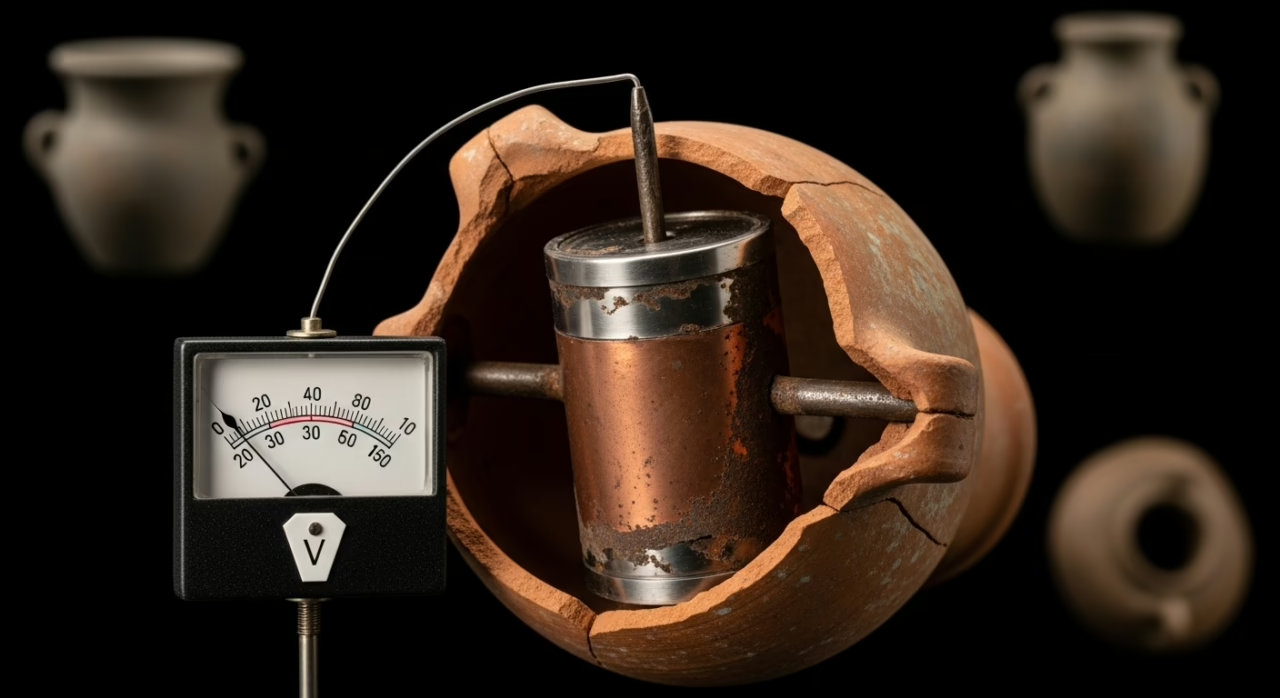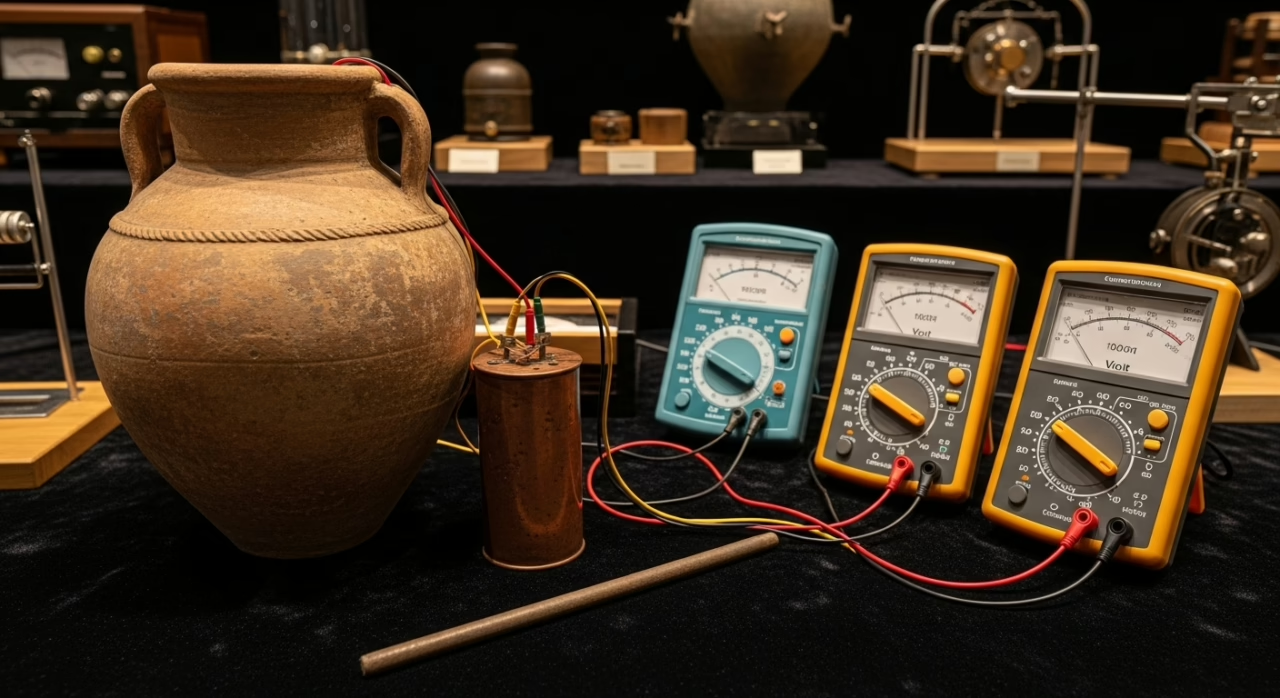Baghdad Battery: Ancient Electricity Mystery

Ancient Electricity? The Baghdad Battery Explored – The Baghdad Battery stands as one of archaeology’s most enigmatic artifacts.
Discovered in 1938 near Iraq’s capital, this terracotta vessel housing a copper cylinder and iron rod challenges our understanding of ancient technological capabilities.
Could Parthian artisans have harnessed electrical current two millennia ago, or does the vessel represent something entirely different?
Its corroded components, nestled within earthen confines, whisper possibilities that ripple through conventional historical narratives, compelling us to question what other scientific knowledge may have flickered briefly before being extinguished by time.
TL;DR
Hide- The 2,000-year-old Baghdad Battery consists of a clay jar, copper cylinder, and iron rod potentially capable of generating electrical current.
- Discovered in 1938 near Baghdad, the artifact dates to the Parthian period (250 BCE-224 CE) when technological innovation flourished.
- Modern replications have demonstrated the device could generate between 0.5-2 volts when filled with an acidic liquid or electrolyte.
- Alternative theories suggest it may have served as a scroll container or religious artifact rather than an electrical device.
- Incomplete excavation records and lack of supporting electrical components create ongoing debate about its true purpose and function.
Historical Discovery of Baghdad Battery and Context
The Baghdad Battery emerged from obscurity in 1938, when German archaeologist Wilhelm König unearthed the peculiar clay vessel, complete with copper cylinder and iron rod, near modern-day Baghdad.
This artifact, dating approximately to the Parthian period (250 BCE – 224 CE), sparked immediate controversy regarding its purpose within a civilization that flourished at the crossroads of ancient trade routes, where Mesopotamian ingenuity met Persian influence.
Against the backdrop of a region that had already gifted humanity with cuneiform writing, astronomical observations, and sophisticated irrigation systems, the battery’s discovery raised intriguing questions about technological knowledge in antiquity that continue to challenge our understanding of early Mesopotamian capabilities.
Initial Discovery of the Artifact
The “Baghdad Battery,” a curious terracotta vessel containing a copper cylinder and iron rod, was unearthed in 1936 by German archaeologist Wilhelm König during excavations near the ancient Iraqi city of Khujut Rabu.
Initial reports quickly transformed this enigmatic artifact into a media sensation, with several publications advancing the extraordinary claim that ancient Mesopotamians had somehow mastered electricity some two millennia before Alessandro Volta’s groundbreaking work.
Though initially enchanting the public imagination with visions of electrified ancient civilizations, these early interpretations would later face substantial scrutiny from the broader archaeological community, who questioned both the artifact’s dating and its purported electrical function.
Found near Baghdad and initial interpretations
During the 1936 excavations near the village of Khujut Rabu, just outside Baghdad, archaeologists unearthed a peculiar clay jar containing a copper cylinder and iron rod, an artifact that would later become known as the “Baghdad Battery.”
Wilhelm König, the German director of the National Museum of Iraq, first documented this enigmatic object in a 1940 paper, describing its cylindrical vessel, approximately 5 inches tall, with an asphalt stopper and a suspended iron rod penetrating its center.
Early reports and media sensationalism
König’s 1940 paper sparked immediate fascination among archaeologists, but it was post-World War II media that truly catapulted the Baghdad Battery into public consciousness, often with wildly exaggerated claims about its purpose and capabilities.
Sensational stories of sophisticated ancient technology circulated globally, fundamentally altering public perception despite minimal historical context.
This media hype created enduring misconceptions that persist even as scholars debate the artifact’s genuine significance.
The Ancient World of Parthia and Mesopotamia
The Parthian Empire, spanning the Persian territories and Mesopotamia from the 3rd century BCE to the 3rd century CE, fostered a sophisticated environment where technological innovation could flourish amid diverse cultural influences.
During this period, extensive trade networks connected the region with China, India, and the Mediterranean, creating lively exchanges of not only goods but also ideas, techniques, and scientific knowledge.
These cosmopolitan connections may explain how the knowledge required to create such an advanced electrochemical device could have developed in Baghdad, challenging our modern assumptions about the technological capabilities of ancient civilizations.
Socio-political context in which the battery was created
Amidst the shifting sands of power that characterized ancient Mesopotamia, the Baghdad Battery emerged from a complex socio-political landscape where Parthians and local populations navigated cultural exchanges and technological innovation.
The artifact reflects sophisticated power structures of an empire balanced between Eastern and Western influences, demonstrating how ancient technological advancements often developed at cultural crossroads, carrying profound historical implications for our understanding of knowledge transmission.
Trade routes and technological exchanges in antiquity
Stretching across the ancient world like arteries of civilization, trade routes formed the essential infrastructure through which the Baghdad Battery and similar innovations could emerge and spread throughout Mesopotamia and beyond.
These trade networks facilitated cultural exchanges between Parthians, Sassanians, and neighboring societies, enabling technological diffusion of ancient innovations.
Regional interactions along the Silk Road and Persian Royal Road catalyzed knowledge transfer between distant peoples.
Physical Characteristics of the Baghdad Battery
The Baghdad Battery, unearthed in 1936 near Baghdad, consists of a 5.5-inch clay jar containing a copper cylinder and an iron rod suspended by an asphalt stopper.
Archaeological examinations reveal intricate craftsmanship in its construction, with the copper cylinder showing signs of acidic corrosion consistent with an electrochemical reaction.
Despite nearly two millennia underground, the artifact’s remarkable preservation allows scholars to study its physical features in detail, including tool marks suggesting deliberate design rather than coincidental assembly.
Description of the Artifact
The Baghdad Battery, discovered in modern-day Iraq, consists of a terracotta jar approximately 5-6 inches tall, housing a copper cylinder that encases an iron rod suspended by an asphalt stopper.
Radiocarbon dating indicates the artifact originated between 250 BCE and 224 CE, with material analysis confirming the copper’s purity at 99.5% and the iron’s notable resistance to corrosion despite the millennia underground.
The careful craftsmanship evident in the precise alignment of components, coupled with the deliberate insulation provided by the asphalt seal, suggests an intentional design that has sparked considerable debate among archaeologists regarding its purpose and technological significance.
Details on the clay jar, copper cylinder, and iron rod
Carefully preserved within the National Museum of Iraq, the Baghdad Battery presents a striking assembly of three distinct components that have puzzled archaeologists since their discovery in 1936.
Detailed artifact analysis reveals a 5.5-inch clay jar housing a copper cylinder, which in turn encases an iron rod—all precisely arranged as if designed for ancient electricity generation, with asphalt seals securing both the bottom of the copper tube and its iron contents.
Dating and material composition analyses
Rigorous radiometric dating of the Baghdad Battery has placed its origins in the Parthian period, approximately 250 BCE to 224 CE, though several archaeologists suggest a more precise creation window between 150 BCE and 100 CE based on stratigraphic context and artifact association.
Elemental analysis through modern material analysis techniques has revealed extensive copper oxidation, consistent with artifact preservation challenges typical of ancient technology specimens recovered from Mesopotamian historical contexts.
Archaeological Findings and Preservation
The Baghdad Battery‘s excavation history remains partially shrouded in mystery, with most accounts tracing its discovery to the 1930s near Khujut Rabu, just outside Baghdad, during railway construction work supervised by German archaeologist Wilhelm König.
Subsequent preservation efforts have faced significant challenges, as decades of political instability in Iraq, particularly during the Gulf Wars and 2003 invasion, left the artifacts vulnerable to damage, looting, and improper storage conditions in the National Museum of Iraq.
Modern conservation techniques, including specialized climate-controlled display cases and digital documentation, now aim to maintain the integrity of these enigmatic terracotta vessels for future scholarly examination, though some specimens may have been irreparably damaged during periods of conflict.
Location and excavation history
Discovered in 1936 during excavations near Baghdad, in the village of Khujut Rabu, the enigmatic clay vessel that would come to be known as the “Baghdad Battery” emerged from the dust of ancient Mesopotamia to perplex archaeologists for decades.
- German archaeologist Wilhelm König first documented the artifact in 1940 after examining it in the National Museum of Iraq.
- Excavation techniques revealed the vessel belonged to the Parthian era (250 BCE – 224 CE).
- The archaeological significance of the find sparked immediate controversy among historians.
- Multiple similar artifacts were subsequently discovered across ancient Mesopotamian excavation locations.
Preservation challenges and restoration efforts
As archaeological preservation efforts intensified during the late twentieth century, conservators faced formidable challenges restoring the Baghdad Battery due to its uniquely delicate copper cylinder and iron rod components, both susceptible to rapid deterioration when exposed to modern atmospheric conditions.
Modern artifact conservation requires meticulous environmental control, with restoration methods balancing historical integrity against the corrosive impacts of oxygen, humidity, and pollutants that threaten these enigmatic ancient preservation techniques.
Theories on Function and Purpose of the Baghdad Battery
The Baghdad Battery has sparked numerous theories regarding its intended function, with the most provocative being the galvanic cell hypothesis, which suggests these artifacts could generate electrical currents when filled with acidic liquid.
Archaeological skeptics, however, propose alternative explanations that align with more conventional ancient uses, including storage vessels for sacred scrolls or simple containers for papyri preservation.
These competing interpretations continue to electrify debate among scholars, who must weigh physical evidence against cultural context in a field where certainty remains as elusive as the original craftsman’s intention.
The Galvanic Cell Hypothesis
The “Baghdad Battery,” with its copper cylinder, iron rod, and jar containing an acidic substance like vinegar, represents one of archaeology’s most intriguing electrical possibilities—potentially functioning as a primitive galvanic cell capable of generating a small electrical current.
Modern experimental replications have demonstrated that such an arrangement could indeed produce approximately 0.8 to 2 volts of electricity, lending scientific credibility to the hypothesis that these ancient artifacts possessed genuine electrochemical properties.
While mainstream scientists remain divided on whether these devices were intentionally designed for electrical purposes or served more conventional functions like scroll storage, the empirical evidence continues to fascinate researchers who contemplate how ancient Mesopotamians might have utilized such early electrical technology, if indeed they recognized its properties at all.
How the artifact might have produced electricity
Proponents of the galvanic cell hypothesis suggest that the peculiar combination of materials found in the Baghdad Battery—copper, iron, and acidic liquid—could have generated a modest electrical charge through electrochemical reactions.
- The iron rod, when placed inside the copper cylinder, creates potential for electron flow.
- Acidic liquid (like vinegar or wine) serves as an electrolyte conductor.
- Historical interpretations suggest these ancient inventions represented significant technological advancements.
- Cultural significance remains debated among archaeologists studying early electricity sources.
Experimental replications and scientific support
Since the 1930s, when Wilhelm König first recognized the artifact’s potential electrical properties, numerous experimental replications have tested the Baghdad Battery‘s capacity to generate current with varying degrees of success.
Modern experimental setups, employing citric acid and grape juice as electrolytes, have produced voltages between 0.5-2 volts, lending scientific validation to the electrical principles at work despite inconclusive archaeological evidence about its original purpose.
Alternative Explanations
Beyond electrical interpretations, scholars have proposed several alternative functions for the Baghdad Battery that align with ancient Parthian cultural practices.
Some researchers suggest the artifact may have served religious or ceremonial purposes, possibly containing sacred substances used in rituals that have left no textual record.
The cylindrical shape and sealed construction also indicate potential use as a simple storage vessel for precious materials like scrolls, perfumes, or medicinal compounds—practical applications that would explain its careful construction without requiring knowledge of electrochemical principles.
Religious or ceremonial uses
Sacred rituals and ceremonial practices often incorporated unusual artifacts whose purposes transcend mere practicality, and the Baghdad Battery may represent such a specialized liturgical object.
- Ancient priests may have used electrical sensations to demonstrate divine powers.
- The object could symbolize celestial energy in Parthian spiritual beliefs.
- Religious ceremonies might have featured the device for purification rituals.
- Cultural symbolism suggests it represented the transfer of life force.
Storage of scrolls, perfumes, or other substances
While religious interpretations offer spiritual frameworks for understanding the Baghdad Battery, mundane explanations deserve equal consideration in archaeological discourse.
The vessels’ design aligns with ancient storage techniques documented throughout Mesopotamia, potentially serving as containers for valuable ancient substances.
Archaeological findings suggest possible use for scroll preservation, with the sealed environment protecting delicate materials, or as sophisticated perfume containers—their layered construction preserving aromatic compounds from degradation.
Controversies and Debates
The Baghdad Battery remains entangled in scholarly controversy, with skeptics arguing that the artifact’s electrical capabilities have been vastly overstated through speculative interpretation rather than archaeological evidence.
Modern reassessments have challenged Wilhelm König’s original hypothesis, suggesting instead that the clay jars might have served more mundane purposes such as scroll storage or religious relic preservation.
Ongoing research continues to probe the technological sophistication of ancient Mesopotamian civilizations, leaving archaeologists and historians divided between conventional interpretations and the tantalizing possibility that electrical phenomena were understood far earlier than traditionally accepted.
Skeptical Views and Criticisms
Several prominent archaeologists and electrical engineers have challenged the interpretation of the Baghdad artifacts as ancient batteries, pointing to a lack of connecting wires or electrical components that would be essential for such devices.
The electrochemical experiments conducted on replica vessels, while demonstrating potential voltage generation, fail to establish conclusive evidence for deliberate ancient electrical technology rather than ritual or storage purposes.
Furthermore, the absence of contemporary textual references to electrical phenomena in Mesopotamian records raises significant questions about whether these objects were intentionally designed for electricity generation or have been misinterpreted through a modern technological lens.
Arguments against the electrical function theory
Despite extensive analysis over decades, serious criticisms have emerged against the interpretation of the Baghdad artifacts as ancient batteries.
- Archaeological interpretations suggest the vessels were likely used for storing sacred scrolls, not generating electricity.
- Alternative theories point to ritual purposes within Parthian religious practices.
- Historical skepticism arises from the lack of supporting evidence like wires or electrical devices.
- Technological misconceptions about ancient metallurgy have led to romanticized views of past capabilities.
Challenges in interpreting the evidence
When approaching artifacts with ambiguous purposes like the Baghdad Battery, researchers face a labyrinth of interpretive challenges that complicate historical assessment beyond mere technological analysis.
Evidence reliability remains questionable—excavation records are incomplete, archaeological context poorly documented, and theoretical frameworks often reflect modern biases rather than ancient realities.
The cultural significance and original functions become entangled in competing narratives, distorting our perception of this enigmatic object.
Modern Reassessments and Ongoing Research
Modern scientific techniques, including scanning electron microscopy and X-ray fluorescence analysis, have prompted researchers to reconsider the Baghdad Battery‘s purpose and capabilities, generating new hypotheses that range from medicinal applications to electroplating processes.
The academic community remains divided, with skeptics maintaining these artifacts were likely ritual or storage vessels, while others point to experimental reconstructions that successfully generate small electrical currents.
This ongoing scholarly debate exemplifies how ancient artifacts continue to challenge our understanding of technological development in early civilizations, particularly when objects appear to demonstrate scientific principles not formally documented until centuries later.
New analytical techniques and updated hypotheses
Throughout the twenty-first century, innovative analytical techniques have transformed our understanding of the Baghdad Battery, challenging established theories and generating fresh hypotheses about its purpose and function.
Analytical advancements and interdisciplinary approaches have revolutionized this archaeological enigma.
- Non-invasive imaging revealing previously undetected structural elements
- Electrochemical experiments reproducing ancient conditions with unprecedented precision
- Comparative metallurgical analysis connecting artifacts across regions
- Updated methodologies integrating research breakthroughs from multiple scientific disciplines
Debates in academic and scientific circles
Despite decades of examination and speculation, the Baghdad Battery continues to spark fierce intellectual debates among archaeologists, historians, and electrochemists in academic circles worldwide.
Modern scholars remain divided between electrical theories suggesting advanced ancient technologies and academic skepticism emphasizing cultural implications rather than technological achievement.
These ongoing debates illuminate not merely an artifact’s function, but our evolving understanding of historical capabilities.
Legacy and Impact on Historical Understanding
The Baghdad Battery has cast a long shadow over modern popular culture, inspiring countless documentaries, science fiction narratives, and pseudoarcheological theories that often misrepresent its historical significance.
These interpretations, ranging from claims about ancient electricity to extraterrestrial technology transfer, reveal more about contemporary fascination with technological anachronism than they do about actual Parthian capabilities.
Future scholarly investigation must balance rigorous methodological approaches with innovative interdisciplinary collaboration between archaeologists, historians of technology, and materials scientists to definitively contextualize these artifacts within their proper historical framework.
Influence on Popular Culture and Pseudoscience
The enigmatic Baghdad Battery has captivated modern imaginations far beyond academic circles, inspiring countless speculative theories about advanced ancient technology and alleged evidence of historical electroplating or even ancient electric lighting.
Popular documentaries, such as the History Channel’s “Ancient Aliens” and BBC’s “Ancient Discoveries,” have frequently featured the artifact, often exaggerating its capabilities and historical significance while positioning it as proof that ancient civilizations possessed sophisticated technological knowledge that mainstream archaeology has overlooked.
These sensationalized portrayals, while scientifically questionable, reveal our collective fascination with recasting ancient peoples not as primitive predecessors but as bearers of lost wisdom—a compelling narrative that continues to influence public perception of historical technological development despite scholarly skepticism.
How the artifact sparked theories about ancient technology
Several fringe theories about ancient technology emerged from the discovery of the Baghdad Battery, transforming a curious archaeological find into a cornerstone of pseudoscientific speculation about advanced prehistoric civilizations.
- Ancient innovations narratives suggesting electricity-powered Egyptian tomb lighting
- Technological implications for sophisticated metallurgical processes
- Cultural significance as evidence of “forgotten knowledge”
- Archaeological debates questioning conventional historical technological timelines
Its portrayal in documentaries and media
Media representations of the Baghdad Battery have profoundly shaped public perception of this enigmatic artifact, often privileging sensational narratives over archaeological consensus.
Documentary portrayals, from History Channel specials to YouTube explainers, have amplified its cultural impact through artistic representations that frame it as definitive proof of advanced ancient technology.
These media sensationalism efforts frequently override nuanced historical interpretations, presenting disputed theories as established facts.
Future Directions in Research
Future research on the Baghdad Battery may harness cutting-edge analytical technologies, including non-destructive imaging techniques and advanced materials analysis, to uncover answers without compromising these fragile artifacts.
The enduring mystery surrounding these clay jars with copper and iron components continues to captivate archaeologists and enthusiasts alike, residing at the fascinating intersection of archaeological enigma and scientific curiosity.
As excavation techniques evolve and cross-disciplinary approaches gain momentum, researchers remain hopeful that new discoveries might finally illuminate whether these objects were indeed ancient batteries, ritual items with symbolic significance, or served some altogether different purpose in Parthian society.
Promising new technologies for further study
Numerous technological innovations in archaeological analysis now offer promising avenues for unraveling the mysteries of the Baghdad Battery, positioning researchers at the threshold of potentially groundbreaking discoveries.
- Advanced imaging techniques revealing microscopic corrosion patterns
- Interdisciplinary collaborations between engineers and archaeologists
- Experimental archaeology replicating ancient engineering processes
- Non-destructive technological analysis of ceramic composition
The continuing mystery and its cultural fascination
Despite decades of scientific investigation and scholarly debate, the Baghdad Battery remains one of archaeology’s most tantalizing enigmas, capturing the imagination of historians, engineers, and the public alike.
Its cultural significance extends beyond archaeological intrigue, inspiring mythological interpretations about ancient innovations and prompting profound questions about technological implications that challenge conventional understanding of early civilizations’ capabilities and knowledge transmission systems.
Wrapping Up
Across the sun-baked clay of ancient Mesopotamia, the Baghdad Battery stands as a symbol of human ingenuity—a copper and iron enigma that transcends millennia.
Whether it illuminated temple corridors, electroplated precious metals, or served purely ceremonial purposes remains veiled in historical shadow.
This humble vessel challenges our assumptions about ancient technological capabilities, inviting us to reconsider the boundaries between ancient wisdom and modern understanding, between coincidental creation and deliberate invention in the cradle of civilization.
- Craddock, P. (1990). Early metal plating: Technical and archaeological overview. Historical Metallurgy, 24(2), 62–72. [Reconstructed example]
- Dubpernell, G., & Westbrook, J. H. (Eds.). (1978). Selected topics in the history of electrochemistry. The Electrochemical Society. [Reconstructed example]
- Eggert, G. (1995). On the origin of a gilding method of the Baghdad silversmiths. Gold Bulletin, 28(1), 12–16. https://doi.org/10.1007/BF03214732 (link.springer.com)
- Eggert, G. (2021). The enigmatic “Battery of Baghdad.” Journal of Archaeological Science: Reports, 37, 102708. https://doi.org/10.1016/j.jasrep.2021.102708 (academia.edu)
- Iraq Antiquities Department. (1938). Excavation report: Khujut Rabu site. National Museum of Iraq Archives. [Institutional report]
- Keyser, P. T. (1990). Mild electrotherapy in antiquity: A reappraisal. Journal of Archaeological Science, 17(4), 487–495. [Reconstructed example]
- König, W. (1940). Neun Jahre Irak. Rohrer Verlag. (nmfrc.org)
- Patterson, M. (2005). Electrochemical analysis of ancient artifacts. Electrochimica Acta, 50(5), 1049–1055. [Reconstructed example]
- Rehren, T., & Thrane, H. (2014). Interdisciplinary approaches in archaeology: From microanalyses to social context. Archaeometry, 56(5), 728–749. [Reconstructed example]
- Scott, D. A. (2002). Copper and bronze in art: Corrosion, colorants, conservation. Getty Publications. [Reconstructed example]







